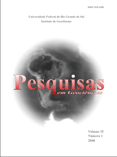O uso de Imagens do Sensor Aster no Mapeamento de Unidades Vulcano- Sedimentares do Platô da Ramada, Vila Nova do Sul, RS
DOI:
https://doi.org/10.22456/1807-9806.19524Palabras clave:
remote sensing, geological mapping, volcanic rocks, principal components.Resumen
The remote sensing products which are generated by orbitals sensors of middle spatial and spectral resolution and the development of new technique of digital image processing has been a auxiliary tool in the basic geological surveys. In this work was utilized images obtained from the ASTER sensor (Advanced Spaceborne Thermal Emission and Reflection Radiometer) to identify the lithologies in the Ramada Plateau area, situated closed to Vila Nova do Sul town, in the southernmost Brazil, giving emphasis to the volcanic sequence of the plateau and the encase sedimentary rocks unit. The volcanic unit represent a important part of the Neoproterozoic alkaline magmatism in the Sul-rio-grandense Shield and is interpreted as one of the volcanic cycles of the post-collisional period of Brasiliano Cycle in the southern Brazil. The selective principal component analysis technique was used in the digital image processing, because it provided the best results enhancing the existent spectral differences of the studied lithologies. In this processing were utilized only two spectral bands to reduce the data dimensionality, permitting a better interpretation of them. The first generated image (PC1) concentrate the common information of the two bands (albedo and topographic shading), while PC2 image present the differential information of the scene, representing the spectral contrast of the two original bands. From this technique was generated a color composite image from the PC’s2 images of the pair of bands 4-5 (R), 3-4 (G) and 8-9 (B). This image has shown the spectral differences between volcanic rocks of the Ramada Plateau and the sedimentary rocks of the Maricá Group and its individualization in two sub-units, mainly considering the concentration of rhyolitic dykes and sills in the north of the area. In this study was identify too in the southwestern portion of the Ramada Plateau, a dioritic intrusive body.



